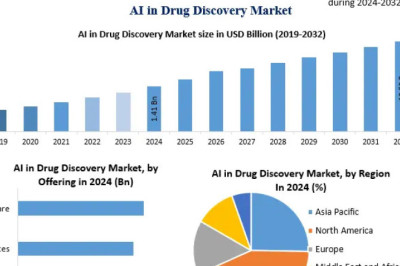views
Ransomware has transformed from a niche cyber threat into one of the most disruptive forces in cybersecurity. Once considered a problem for only large organizations, ransomware attacks now target small businesses, schools, hospitals, and individuals. Why has ransomware grown so quickly? And more importantly, what does this surge mean for you, your privacy, and your livelihood? This blog provides an in-depth ransomware review, explores the factors fueling its rise, and offers practical steps to protect against cyberattacks.
Understanding Ransomware: A Brief Overview
What Is Ransomware?
Ransomware is a type of malicious software (malware) that encrypts the files on a victim’s device or network, making them inaccessible. Attackers then demand a ransom payment, typically in cryptocurrency, for the decryption key. Refusal to pay can result in data loss, leaks, or even permanent exposure of sensitive information.
How Has Ransomware Evolved?
Ransomware has evolved from simple “locker” programs targeting single users to sophisticated campaigns that cripple entire corporate networks or public infrastructure. Modern strains can:
- Spread automatically across networks
- Target backups and cloud storage
- Exfiltrate data for “double extortion” tactics
- Disrupt essential services like healthcare or city management
Understanding these advancements is crucial for any ransomware review or cyberattack preparedness plan.
Unpacking the Ransomware Surge
1. Explosive Rise in Ransomware Attacks
Recent years have seen ransomware review attacks multiply at an alarming rate. According to the 2023 Threat Landscape Report by ENISA, ransomware accounted for over 25% of all significant cyber incidents in Europe, a trend mirrored globally.
Notable Stats for a Ransomware Review
- The average ransomware payment in 2022 exceeded $250,000 (Coveware).
- 66% of organizations reported at least one ransomware attack in the past year (Sophos).
- Attackers increasingly target small and mid-sized businesses, often due to weaker defenses.
2. Why Is Ransomware Growing?
A few key factors are driving ransomware proliferation:
- Easy-to-use Ransomware-as-a-Service (RaaS): Criminals now “rent” or purchase ransomware on dark web marketplaces, making it accessible to less technical threat actors.
- Cryptocurrency payments: Cryptocurrencies like Bitcoin allow attackers to receive payments while concealing their identities.
- Remote work vulnerabilities: The shift to remote work expanded attack surfaces, as unsecured home networks and personal devices became targets.
- Better targeting: Attackers use phishing, spear phishing, and social engineering to craft convincing lures and gain access to sensitive data.
3. The Human Cost Behind the Headlines
Numbers only tell part of the story. Cyberattacks disrupt hospitals (forcing life-support patients to relocate), shut down critical infrastructure (causing fuel shortages), and lock small business owners out of their entire systems. Beyond financial losses, ransomware damages reputations, erodes trust, and sometimes puts lives at risk.
Anatomy of a Modern Ransomware Attack
Step 1: Initial Compromise
Attackers often begin with phishing emails containing malicious attachments or links. Sometimes, they exploit vulnerabilities in remote desktop protocols (RDP) or VPNs.
Step 2: Reconnaissance and Escalation
Once inside, hackers move laterally, searching for sensitive data or backup systems. They escalate privileges to gain deeper access.
Step 3: Encryption and Exfiltration
Files across the network are encrypted, and backup copies are targeted or deleted. Increasingly, attackers also transfer stolen data to their own servers, threatening public leaks unless the ransom is paid (“double extortion”).
Step 4: Ransom Demand and Negotiation
Victims receive instructions to pay a ransom for decryption. Some groups even provide “customer support” to facilitate payment and restore access.
Step 5: Aftermath
Even if a ransom is paid, recovery can be slow. There’s no guarantee of full data restoration or that attackers haven’t kept copies of sensitive files.
Industries Most at Risk
Healthcare
Hospitals and clinics store large amounts of sensitive data but often lack the resources for strong cybersecurity. Ransomware attacks can threaten patient care and safety.
Education
Schools and universities face chronically tight IT budgets and rely on outdated infrastructure. A single cyberattack can disrupt operations for days or weeks.
Businesses of All Sizes
From law firms to manufacturers, companies are attractive targets for ransomware due to their business-critical data and often inadequate backup strategies.
Government and Infrastructure
Municipalities, police departments, and utilities run on legacy systems that are hard to secure. Attackers may aim for maximum disruption, as seen in ransomware review case studies on city-wide outages.
The Ransomware Economy
Ransomware-as-a-Service Explained
Just as businesses move to subscription models, so do cybercriminals. Ransomware developers license their malware via RaaS, providing user-friendly dashboards, payment portals, and even “tech support” for criminals. Profits are split between developers (who maintain the software) and affiliates (who launch attacks).
Ransom Payments and the Role of Cryptocurrency
Bitcoin and other cryptocurrencies are the preferred payment method for ransoms. Their pseudo-anonymous nature helps attackers avoid law enforcement. Some ransomware groups will adjust ransom amounts based on the victim’s size, ensuring payments remain slightly less than the cost of recovery.
The Impact of Paying Ransoms
Law enforcement agencies advise against paying ransoms. While paying may seem like the quick fix, it fuels future attacks, encourages criminal activity, and offers no guarantee against data leaks.
How to Protect Yourself from a Ransomware Cyberattack?
Build Strong Defenses
- Update and patch systems: Keep operating systems, software, and plugins current.
- Back up everything: Maintain regular, offline backups. Test recovery processes frequently.
- Segment networks: Limit access so attackers can’t move laterally across your network.
- Multi-factor authentication: Require MFA for remote access and critical accounts.
Educate Your Team
Most ransomware review reports blame human error for initial breaches. Train staff to recognize phishing emails and avoid suspicious downloads.
Use Security Tools
- Email filters to catch malicious attachments and links
- Endpoint detection and response (EDR) to spot unusual activity
- Firewalls and anti-malware software
- Intrusion detection and prevention systems
Prepare for the Worst
Have a comprehensive incident response plan. Identify critical assets, create communication templates, and simulate drills. Quick, coordinated action is key to damage control.
What Happens If You Become a Victim?
Contain and Assess
Disconnect infected devices and isolate affected systems as quickly as possible. Notify your IT team or security partners.
Communicate Transparently
Determine the breach's scope, inform stakeholders, and follow regulatory requirements for reporting. Clear communication with employees, clients, and (if needed) authorities minimizes confusion and reputational fallout.
Engage Experts
Cybersecurity consultants and law enforcement can assist with recovery, negotiation (if unavoidable), and forensics.
Learn and Improve
After recovery, conduct a post-mortem. How did attackers gain access? What gaps were exploited? Were backups accessible? Use these lessons to strengthen your defenses.
Looking Ahead: The Future of Ransomware
Advanced Tactics and Techniques
Ransomware groups are combining tactics, such as:
- Data exfiltration and public leaks
- Threatening DDoS attacks
- Targeting cloud services
Machine learning and AI may enable smarter targeting or stealthier attacks.
Increased Collaboration Among Criminals
Expect more organized ransomware gangs sharing resources, intelligence, and infrastructure. RaaS platforms will get more sophisticated, further lowering entry barriers for aspiring criminals.
Tougher Regulations and Response
Governments and regulatory bodies are ramping up pressure, introducing stricter reporting requirements and penalizing those who pay ransoms. Global cooperation is essential, but progress remains slow.
Strengthen Your Defenses and Stay Proactive
Ransomware is an evolving threat that shows no signs of slowing down. Everyone—from individuals to enterprises—must take these attacks seriously. By understanding why ransomware is growing, investing in strong cybersecurity today hygiene, and knowing how to respond, you can reduce your risk and recover more effectively if attacked.
For a more in-depth ransomware review, credible security research, and the latest cyberattack prevention tips, subscribe to trusted cybersecurity resources and stay updated. The fight against ransomware isn’t just about technology. It starts with awareness, planning, and a commitment to continuous improvement.











